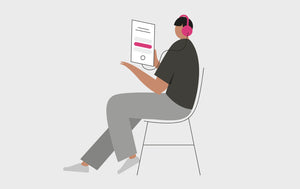History and development of hearing aids over time
The history of hearing aids is surprisingly detailed and stretches further back than you might think. It started with a trumpet or horn, evolving over the years to a cumbersome transistor device that would be strapped around the body. In recent decades devices fitting behind-the-ear became common, which have since become smaller and smaller. Now hearing aids can fit inside the ear canal and are almost invisible.
Why are hearing aids needed?
 Over 10 million people in the UK currently suffer from hearing loss, which translates to one in six of the population. Out of that, 3.7 million are of working age, between 16-64 years old. A further 6.3 million are retired, aged 65+. In excess of 800,000 people in the UK are severely or profoundly deaf. They estimate that 14.5 million people in the UK will suffer a hearing loss by 2031. Over 2 million people own a hearing aid in the UK, but only 1.4 million use them on a regular basis. Over 4 million people who don't currently own a hearing aid, would benefit from using one.
Over 10 million people in the UK currently suffer from hearing loss, which translates to one in six of the population. Out of that, 3.7 million are of working age, between 16-64 years old. A further 6.3 million are retired, aged 65+. In excess of 800,000 people in the UK are severely or profoundly deaf. They estimate that 14.5 million people in the UK will suffer a hearing loss by 2031. Over 2 million people own a hearing aid in the UK, but only 1.4 million use them on a regular basis. Over 4 million people who don't currently own a hearing aid, would benefit from using one.
How do modern hearing aids help?
 Thanks to the development of technology, hearing aids today enable you to access the hearing world better than ever before. They cannot claim to fix your hearing loss but they can go a long way to help:
Thanks to the development of technology, hearing aids today enable you to access the hearing world better than ever before. They cannot claim to fix your hearing loss but they can go a long way to help:
- Amplify sound - making speech accessible.
- Enhance general hearing ability and comfort.
- Enable you to listen with far less effort and concentration required.
- Microphone
- Chips
- Receivers
- Battery to supply power
The History of Hearing Aids
To start the history of hearing aids we need to go back to the 17th Century... 

Acoustic Era - 13th century to 1930s
From the most primitive animal horns in the 13th century to a more complex hearing trumpet with an ear tip, first devised in 1692 by Nuck - acoustic hearing aids have been around for centuries. They were at their height of popularity in the 17th and 18th centuries with tin trumpets still in use in the 1930s. In 1673 Dekker produced a simple funnel device. These amplified cones captured sound energy and directed it into the ear canal.
Carbon Era - 1902 - 1939
 Alexander Bell invented the telephone in 1876 and this new technology paved the way for the hearing aids to take shape. Bell's invention inspired Bake and Hughes in 1878 to create a carbon transmitter capable of amplifying sound. In 1902, Miller Reese Hutchison invented the first wearable carbon hearing aid for the U.S. market. A carbon hearing aid consisted of a microphone and magnetic receiver, a battery and connecting cables. The invention of the Vaccum-tube hearing aid replaced these. There were disadvantages:
Alexander Bell invented the telephone in 1876 and this new technology paved the way for the hearing aids to take shape. Bell's invention inspired Bake and Hughes in 1878 to create a carbon transmitter capable of amplifying sound. In 1902, Miller Reese Hutchison invented the first wearable carbon hearing aid for the U.S. market. A carbon hearing aid consisted of a microphone and magnetic receiver, a battery and connecting cables. The invention of the Vaccum-tube hearing aid replaced these. There were disadvantages:
- If lying flat, the hearing aid would not operate
- Only suitable for mild to moderate hearing loss
- Sound interference due to the movement of carbon balls on the diaphragm.
- Limited frequency range.
Vacuum-tube Era - 1921 - 1952
 This new technology allowed for less noise interference, a wider frequency range and greater amplification. Hanson in 1920 invented the first vacuum tube known as 'Vactuphone' which was later distributed by Globe Phone Co. in October 1921. Tillyer and Kranz in 1923 and 1928 introduced hearing aids with carbon microphones and vacuum technology to create a greater frequency response to meet the needs of people with more severe hearing impairment. E.A. Myers invented a multi-tube hearing aid called the Radioear in 1924. Instead of a carbon microphone, he used a coil microphone and a rubber diaphragm, which helped to eliminate internal interference and improved sound quality. A wearable vacuum tube hearing aid was first produced in 1937, complete with Rochelle Salts Crystal microphone. The inventor was Sawyer of Brush Development Company. It is during this era that tube sizes were reduced, ensuring that hearing aids could also be made smaller. Carbon zinc batteries were replaced with smaller type 'B' batteries that would last longer and were significantly lighter. Instead of carrying your hearing aid around with you, or strapping it to your body, you could now wear your hearing aid. This was a huge leap in technology. In 1946 Radioear introduced a hearing aid that contained a built-in telecoil facility, enabling the wearer to use their device on the phone. The crystal microphones, so sensitive to humidity and warm temperatures were replaced with magnetic microphones for maximum effect.
This new technology allowed for less noise interference, a wider frequency range and greater amplification. Hanson in 1920 invented the first vacuum tube known as 'Vactuphone' which was later distributed by Globe Phone Co. in October 1921. Tillyer and Kranz in 1923 and 1928 introduced hearing aids with carbon microphones and vacuum technology to create a greater frequency response to meet the needs of people with more severe hearing impairment. E.A. Myers invented a multi-tube hearing aid called the Radioear in 1924. Instead of a carbon microphone, he used a coil microphone and a rubber diaphragm, which helped to eliminate internal interference and improved sound quality. A wearable vacuum tube hearing aid was first produced in 1937, complete with Rochelle Salts Crystal microphone. The inventor was Sawyer of Brush Development Company. It is during this era that tube sizes were reduced, ensuring that hearing aids could also be made smaller. Carbon zinc batteries were replaced with smaller type 'B' batteries that would last longer and were significantly lighter. Instead of carrying your hearing aid around with you, or strapping it to your body, you could now wear your hearing aid. This was a huge leap in technology. In 1946 Radioear introduced a hearing aid that contained a built-in telecoil facility, enabling the wearer to use their device on the phone. The crystal microphones, so sensitive to humidity and warm temperatures were replaced with magnetic microphones for maximum effect.
Transistor Era - 1952 - 1985
 In 1948 Bell Labs invented the transistor. One small battery replaced the 'A' and 'B' batteries - sufficient to work in tandem with the transistor. At first, a hybrid vacuum tube/transistor hearing aid was introduced reducing the cost of hearing aids and opening up the technology to more people. The first transistor hearing aid was the Sonotone Model 1010, distributed in 1952. Fully converted transistor hearing aids followed shortly after in 1953. The size of these hearing aids became smaller over the following decade.
In 1948 Bell Labs invented the transistor. One small battery replaced the 'A' and 'B' batteries - sufficient to work in tandem with the transistor. At first, a hybrid vacuum tube/transistor hearing aid was introduced reducing the cost of hearing aids and opening up the technology to more people. The first transistor hearing aid was the Sonotone Model 1010, distributed in 1952. Fully converted transistor hearing aids followed shortly after in 1953. The size of these hearing aids became smaller over the following decade.
Microelectronic / Digital Era - 1962 - present day
 In 1967 ceramic versions replaced magnetic microphones. As a result of this new technology, the frequency range increased and the physical size of the hearing aid reduced. 1969 saw the introduction of the first miniature directional microphone. From the 1970s onwards, the hearing aid models began to resemble the modern devices for hearing impairment we know today. The introduction of the electret/FET microphone played an important role in every hearing aid. It meant that the receiver and the microphone could be kept in one case which lead to the development of behind the ear, in the ear and in the canal hearing aids.
In 1967 ceramic versions replaced magnetic microphones. As a result of this new technology, the frequency range increased and the physical size of the hearing aid reduced. 1969 saw the introduction of the first miniature directional microphone. From the 1970s onwards, the hearing aid models began to resemble the modern devices for hearing impairment we know today. The introduction of the electret/FET microphone played an important role in every hearing aid. It meant that the receiver and the microphone could be kept in one case which lead to the development of behind the ear, in the ear and in the canal hearing aids.
The first cochlear implant took place in 1981. In 1988 Knowles invented the first amplified receiver worn inside the ear canal, thanks to a further size reduction. A programmable hearing aid quickly followed, meaning that the user could decide on the frequency and output best for their individual needs. Audiotone produced the first wearable digital hearing aid in the US, in 1988. Since this date, they've exploded onto the hearing aid market with various styles including Behind the Ear, In the Ear and In the Canal hearing aids. By 2005, 90% of the hearing aid fittings used digital signal processing technology as opposed to analogue technology. Most have directional microphones and feedback cancellation and often offer many other features to enhance your listening experience.
What does the future hold?
 We can thankfully consign much old fashioned, clunky technology to the bin. The history of hearing aids is full of innovation, particularly in the last 30 years. Digital hearing aids have all but replaced their analogue counterparts. With this very versatile technology, the industry is constantly finding ways of creating new and exciting products that challenge even the very latest hearing aids in comfort, size, performance and style. Hearing aids just keep getting smaller and the sound that they generate is becoming clearer and more powerful. Conceptual designs for the future include hearing aids incorporated into sophisticated jewellery.
We can thankfully consign much old fashioned, clunky technology to the bin. The history of hearing aids is full of innovation, particularly in the last 30 years. Digital hearing aids have all but replaced their analogue counterparts. With this very versatile technology, the industry is constantly finding ways of creating new and exciting products that challenge even the very latest hearing aids in comfort, size, performance and style. Hearing aids just keep getting smaller and the sound that they generate is becoming clearer and more powerful. Conceptual designs for the future include hearing aids incorporated into sophisticated jewellery.
About Hearing Direct
We are one of the world's leading hearing aid specialists. HearingDirect offers a wide range of affordable products, and information resources to help improve the quality of life for the hard of hearing. We sell:- Hearing aids,
- Batteries,
- Accessories such as earplugs,
- and amplified devices such as super loud alarm clocks and amplified phones.
Don't forget to like our Facebook Page


